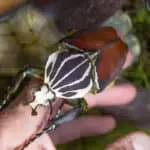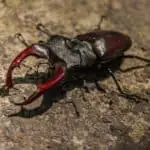Imagine this: it’s late summer, and you’re walking through the woods when you spot it—an Eastern Hercules beetle, its glossy armor glinting under the moonlight. With its iconic horn and gentle demeanor, you can’t help but wonder, Could I keep this magnificent creature as a pet?
The answer is a resounding yes! Eastern Hercules beetles (Dynastes tityus) are low-maintenance, fascinating pets perfect for beginners. In this guide, I’ll share everything you need to know to care for these beetles, troubleshoot common issues, and even breed your own little beetle army. Let’s dive in!
- Meet the Eastern Hercules Beetle
- Why Choose an Eastern Hercules Beetle?
- How to Get Your First Eastern Hercules Beetle
- Setting Up the Perfect Beetle Home
- Feeding Your Eastern Hercules Beetle
- Breeding Eastern Hercules Beetles
- Caring for Grubs
- Recommended Supplies
- Dormant Period
- Color of Eastern Hercules Beetles
- Handling the Beetles
- Troubleshooting Common Problems
- Final Thoughts
Meet the Eastern Hercules Beetle
Eastern Hercules beetles, native to the Eastern United States, are part of the rhinoceros beetle family. While they’re not as massive as their tropical cousins, they still command attention with their impressive horns. Here’s what makes them special:
- Size: Males grow up to 2.75” (~7 cm) long, including their horn.
- Lifespan: Adults live 6-12 months on average, though some reach up to 23 months.
- Unique Traits: Males sport two horns for jousting other males, while females are hornless but equally charming.
Fun fact: Eastern Hercules beetles can interbreed with their western relatives to produce hybrids. Imagine the possibilities!
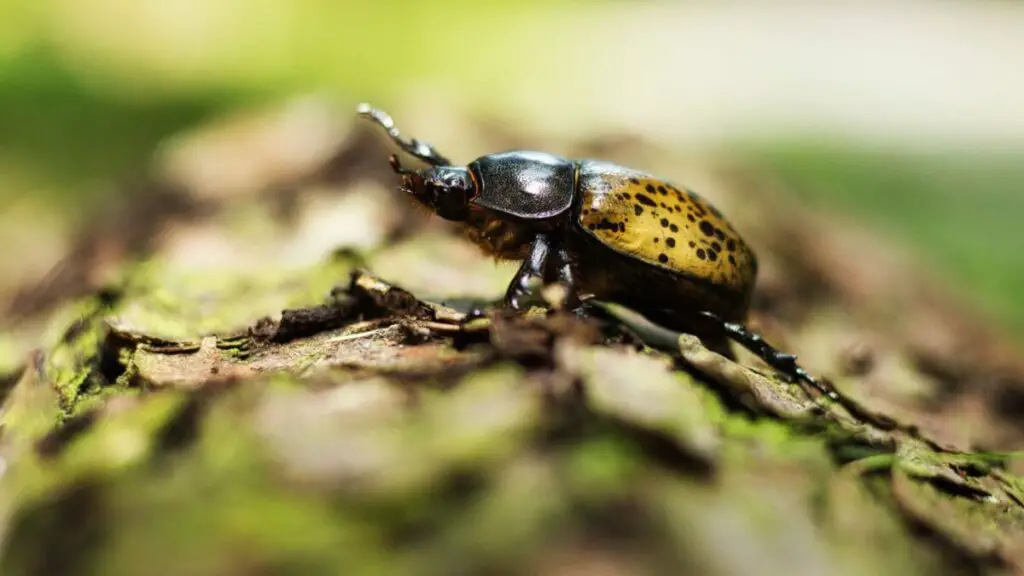
Why Choose an Eastern Hercules Beetle?
These beetles are perfect for beginners because:
- They’re odorless and non-aggressive.
- They don’t need much space.
- They’re easy to feed and care for.
If that’s not enough, they’re also quiet roommates who won’t complain about your late-night Netflix binges.
How to Get Your First Eastern Hercules Beetle
You have two options: buy one or catch one.
Buying Beetles:
- Where to Buy: Local pet stores or online shops. Always check reviews to avoid scams.
- Grubs vs. Adults: Grubs are cheaper but require patience. Buy 2 or more grubs since not all can survive to adulthood; Meanwhile, adults are ready-to-go but expensive and live shorter lives.
- What to Check: Ensure your beetle is healthy (no missing limbs, no injuries) and not nearing the end of its lifespan.
Catching Beetles:
If you’re feeling adventurous, try catching them during summer in wooded areas of the Eastern U.S. (up to east Texas). Refer to this map to have a better idea on the distribution of the eastern Hercules beetles.
- Set up a black light and white sheet in a dark, open area.
- Wait for insects to flock to the light.
- Cross your fingers for a Hercules beetle to appear!
Setting Up the Perfect Beetle Home
Your beetle’s happiness starts with a cozy and safe environment. Here’s how to create it:
Tank
The dimension of your housing for a beetle should be at least 3 times the length of your beetle in length, 2 times in width and 2 times in height. For each additional beetle, increase another 50% to the length and width of the housing.
- Single Male: 1.5-gallon (5 L) tank or bigger. Do not keep more than 1 male in the same tank.
- Females: Can be kept in separate tanks or together in the same tank. Increase tank size by 50% for each additional beetle. Do not mix with male.
Substrate
- Use pesticide-free soil mixed with peat moss (1:1 ratio) or non-soil options like hay and coir.
- Fill the tank with 3-4 inches (7.5-10 cm) of substrate for burrowing.
Accessories
- Add tree bark or branches for climbing. This helps beetles flip themselves if they fall over.
- Use a secure, ventilated lid to prevent escapes—these beetles can fly!
Placement
- Adult eastern Hercules beetles are nocturnal creatures. Keep the tank away from direct sunlight.
- Maintain a temperature of 68-77°F (20-25°C).
- Mist daily to maintain moisture but avoid overwatering.
Feeding Your Eastern Hercules Beetle
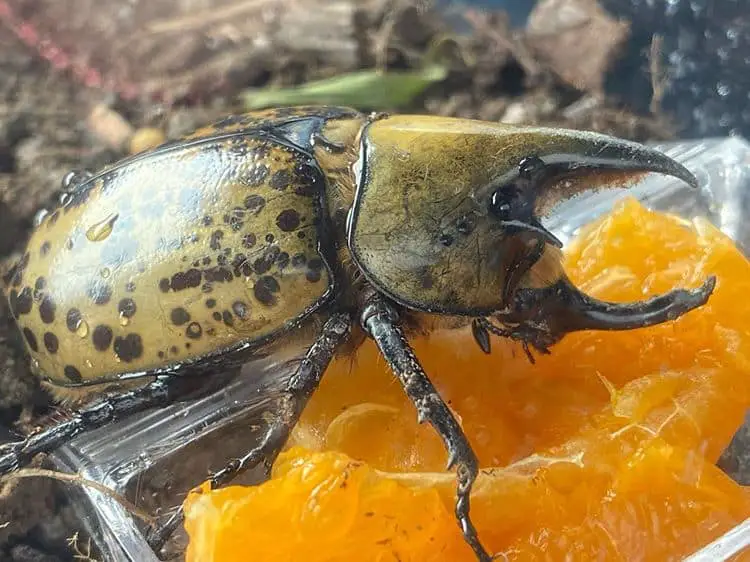
These beetles aren’t picky eaters, but here’s how to keep them happy:
- Fruits: Offer slices of banana, orange, apple, or pineapple (half their body size). Replace daily to prevent mold.
- Beetle Jelly: A convenient, longer-lasting (up to a week) alternative. Some jellies even promote better health and offspring. Here is a recipe of beetle jelly that you can DIY.
Pro tip: Beetles get all the water they need from their food, so no extra water is necessary.
Breeding Eastern Hercules Beetles
Breeding these beetles is straightforward, but timing is key. Younger adults have higher fertility and fecundity than their older counterparts.
Pairing: Place a male and female together. The male will mount the female to mate. If either resists, separate them and try again after a week or two. Do note that mating will reduce the lifespan of the beetles.
Post-Mating: Separate the pair to reduce stress and prevent the male from pestering the female.
Gravid Female: Move her to a 16-gallon (60 L), ventilated nursery chamber filled with 8 inches (20 cm) of moist flake soil (refer to recipe). Place the chamber away from direct sunlight. She’ll lay 40-100 eggs in a few weeks, which will hatch in around 30 days. During this period, she might stop feeding.
Caring for Grubs
Grubs are easy to care for, but the choice between individual and communal housing can impact their growth and development. Here’s what you need to know:
Individual Housing
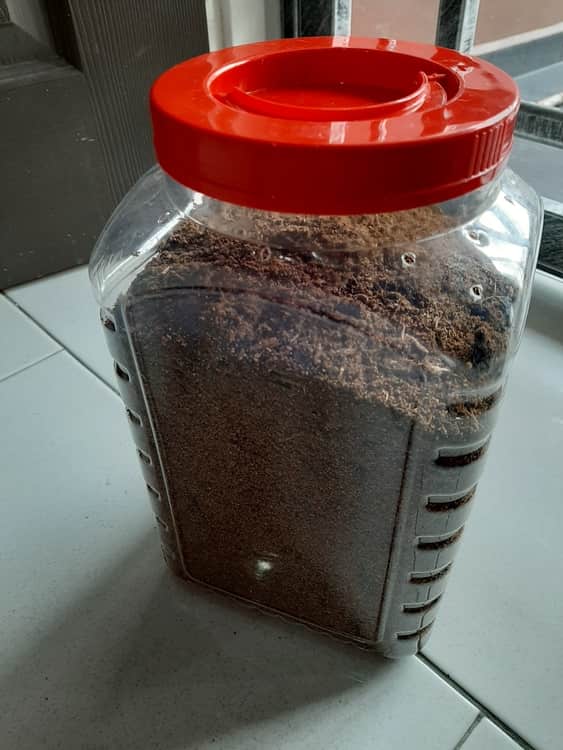
Each grub is placed in its own container filled with moist flake soil. 3rd instar grubs require a 1-gallon (4 L) container.
Pros:
- Produces larger beetles due to reduced competition for food.
- Limits the spread of disease or mites if one grub becomes infected.
- Easier to monitor individual growth and health.
Cons:
- Requires more space and resources.
- Growth synchronization is challenging, with females often maturing months ahead of males.
Communal Housing
Multiple grubs are housed together in a large nursery chamber.
Pros:
- Encourages synchronized growth due to pheromone exchange, increasing the likelihood of males and females maturing simultaneously.
- Saves space and reduces the number of containers needed.
Cons:
- Increased competition for food may result in smaller beetles.
- Higher risk of widespread infection or substrate issues affecting the entire group.
Substrate and Care
- Moisture: Keep flake soil moist but not waterlogged. Squeeze it in your hand—it should hold its shape but not drip.
- Feeding: Grubs naturally feed on rotting wood and soil. For extra protein, mix in dog food powder to promote larger growth.
- Cleaning: Replace 70% of the substrate when half of them turned in to droppings, keeping some old substrate to maintain microbial balance to promote growth.
Molting and Pupation
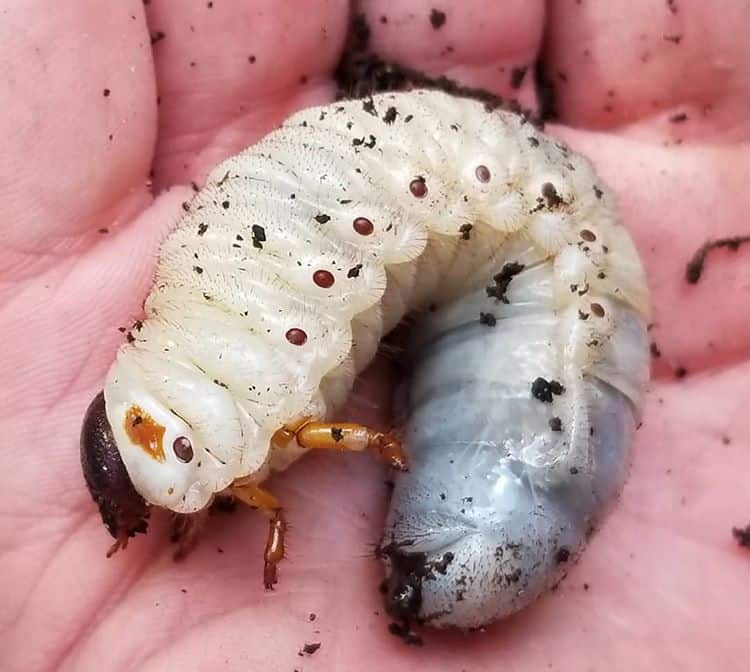
Grubs molt three times over 12-18 months. Depending on the temperature and food, it takes around 3 weeks for the first molt and another 6 weeks for the subsequent molt to occur. The 3rd molt happens around 12 to 18 months from egg hatching. You can sex the grubs before their 3rd molt.
Female: No marking.
Male: Small marking on the ventral side of the third-to-last abdominal segment.
Once you notice them building pupation chambers, ensure the substrate is stable and undisturbed. If you accidentally break a chamber, follow this guide to save your beetle.
Recommended Supplies
Here’s my recommendation on things that you can get for your beetle. Note that I get a small commission when you buy the items through the links in this page. This helps me to maintain the site without incurring additional costs to you.
- Housing for adult beetle
- Substrates for adult beetles
- Beetle Jelly
- Nursery housing
- Housing for grubs
- Heat mat
- Thermometer & Hygrometer
Dormant Period
A newly emerged adult has soft skin and will remain dormant for 4-6 months. It is known as a teneral at this stage until the skin fully hardened. It is best to keep the temperature around 59 °F (15 °C) during this stage. Note that this is usually inline with the winter period.
While you can skip the dormancy or “activate” the beetle earlier by keeping the temperature at around 68-77 °F (20-25 °C), there might be negative effects on the fertility of beetles and egg hatchability.
Read more on how to take care of your beetle during dormant period here.
Eastern Hercules beetles originated from Florida don’t seem to undergo a significant dormancy period, probably because the beetles are already accustomed to the warmer climate in Florida.
Color of Eastern Hercules Beetles
A newly emerged eastern Hercules beetle has white elytra. The elytra slowly turns amber, then black. You should see the elytra’s color turning from black to gray/tan/green as the beetle exits the teneral stage.
The color of the elytra is affected by moisture of the environment. In a drier environment, the elytra is darker and vice-versa.
Handling the Beetles
These beetles are docile, but handle them gently:
- Never forcefully pull beetles from surfaces to avoid breaking their legs.
- Always hold by the thorax, not the legs.
- Avoid dropping grubs—they’re fragile and may not survive a fall.
Troubleshooting Common Problems
Moisture Issues
- Too Dry: Grubs can suffocate. Add water slowly to moisten the substrate.
- Too Wet: Mold can grow. Remove excess water and replace damp soil.
Mites
Baking your substrate before use helps prevent mites. If mites appear, replace all substrate and clean the container thoroughly.
Final Thoughts
Eastern Hercules beetles are more than just pets; they’re a gateway into the fascinating world of exotic insects. Whether you’re marveling at their strength, watching them burrow, or raising a new generation of beetles, there’s always something to learn and enjoy.
Don’t forget to check out our recommended supplies and guides for even more beetle wisdom.

